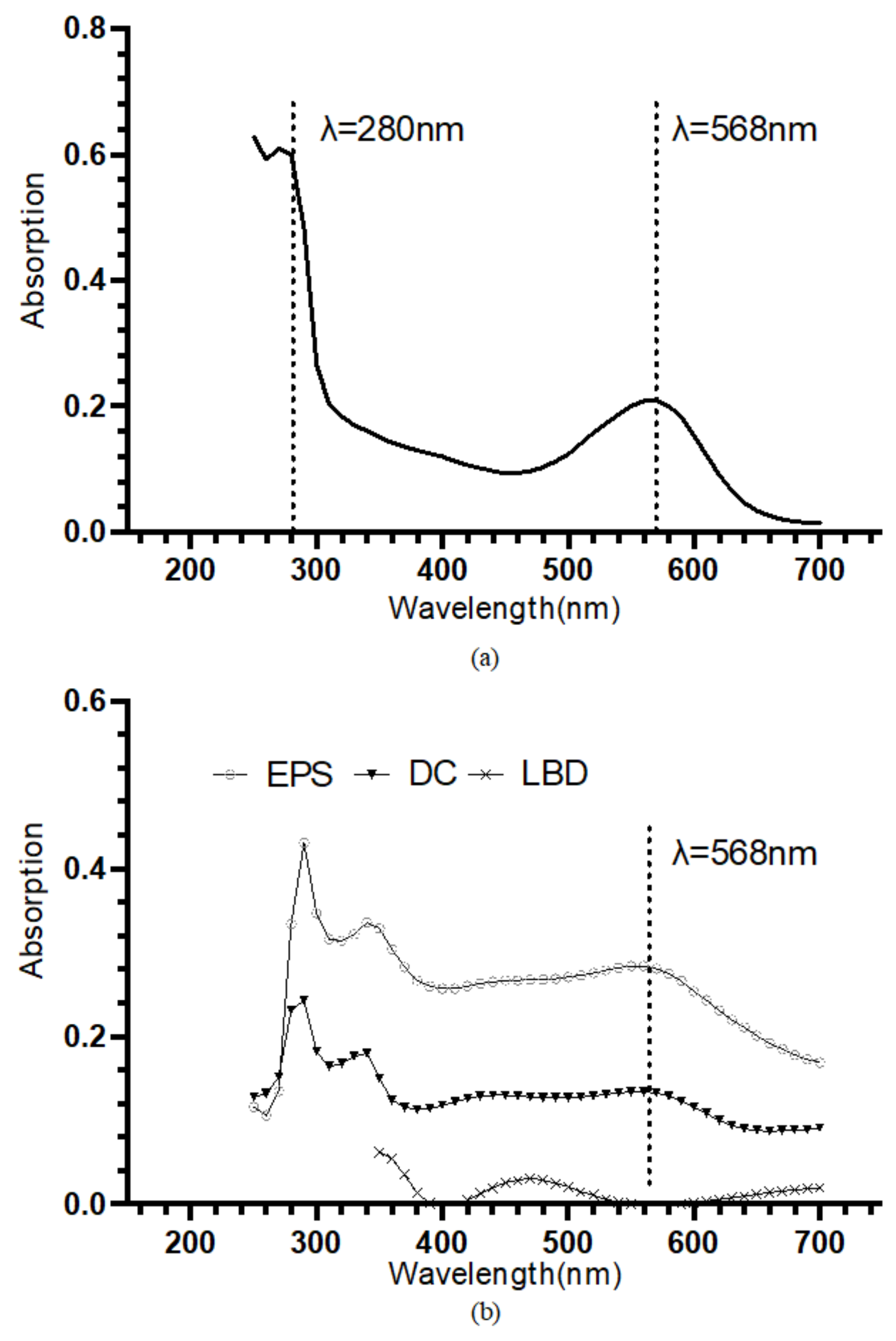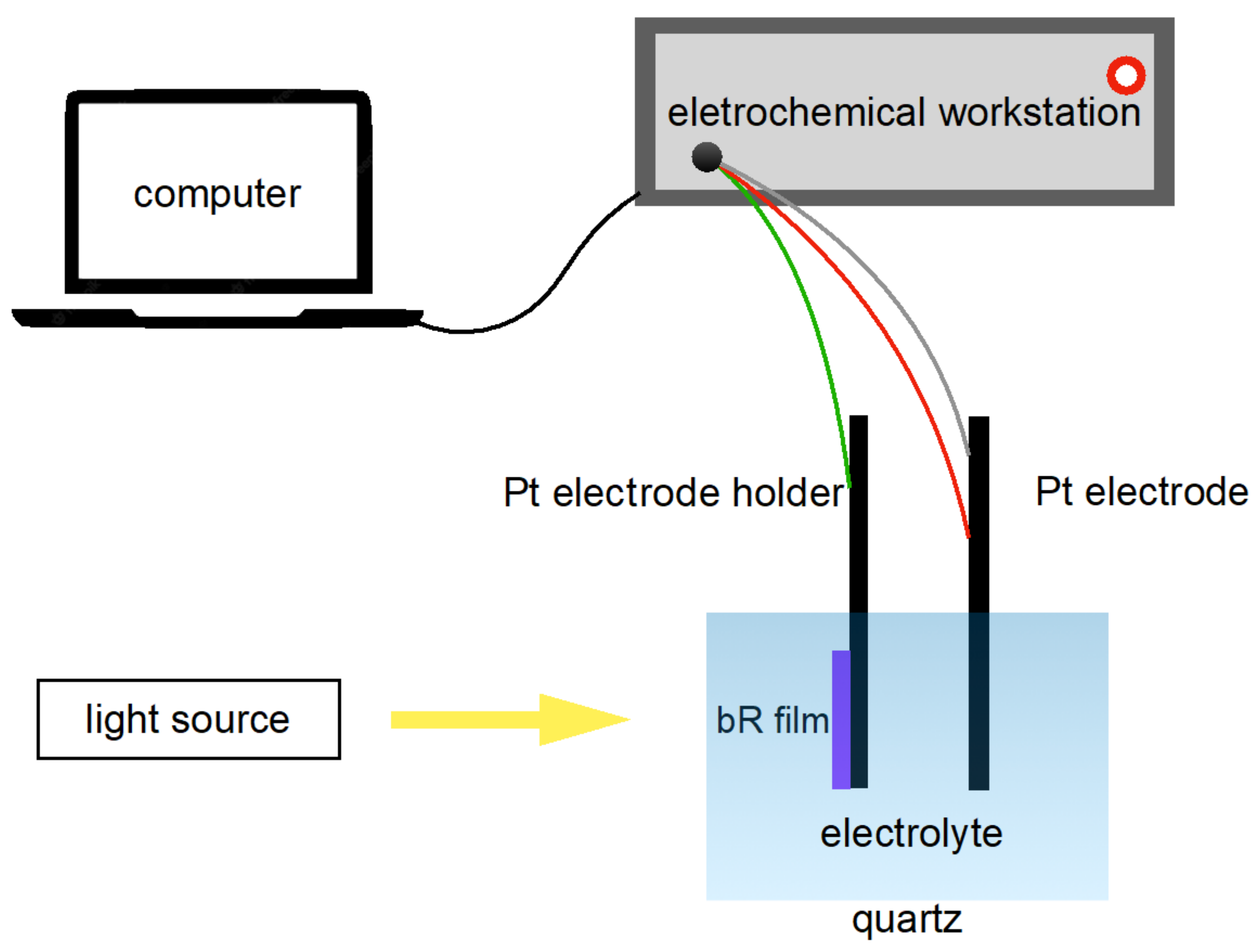Engineered Bacteriorhodopsin Film with Oriented Patterns for the Improvement of the Photoelectric Response
Abstract
1. Introduction
2. Result and Discussion
2.1. Topography and Absorption Spectrum
2.2. Photocurrent Response
2.3. Efficiency Factor
3. Experimental Methods
3.1. Immobilization of Bacteriorhodopsin
3.2. Topographical Characterization
3.3. Photocurrent Response Measurement
4. Conclusions
Supplementary Materials
Author Contributions
Funding
Institutional Review Board Statement
Informed Consent Statement
Data Availability Statement
Conflicts of Interest
Abbreviations
References
- Kannan, N.; Vakeesan, D. Solar energy for future world:—A review. Renew. Sustain. Energy Rev. 2016, 62, 1092–1105. [Google Scholar] [CrossRef]
- Mekhilef, S.; Saidur, R.; Safari, A. A review on solar energy use in industries. Renew. Sustain. Energy Rev. 2011, 15, 1777–1790. [Google Scholar] [CrossRef]
- Halls, J.J.M.; Walsh, C.A.; Greenham, N.C.; Marseglia, E.A.; Friend, R.H.; Moratti, S.C.; Holmes, A.B. Efficient photodiodes from interpenetrating polymer networks. Nature 1995, 376, 498–500. [Google Scholar] [CrossRef]
- Hall, R. Silicon photovoltaic cells. Solid-State Electron. 1981, 24, 595–616. [Google Scholar] [CrossRef]
- Köhler, M.; Pomaska, M.; Procel, P.; Santbergen, R.; Zamchiy, A.; Macco, B.; Lambertz, A.; Duan, W.; Cao, P.; Klingebiel, B.; et al. A silicon carbide-based highly transparent passivating contact for crystalline silicon solar cells approaching efficiencies of 24%. Nat. Energy 2021, 6, 529–537. [Google Scholar] [CrossRef]
- Gobat, A.R.; Lamorte, M.F.; McIver, G.W. Characteristics of High-Conversion-Efficiency Gallium-Arsenide Solar Cells. IRE Trans. Mil. Electron. 1962, MIL-6, 20–27. [Google Scholar] [CrossRef]
- Metaferia, W.; Schulte, K.L.; Simon, J.; Johnston, S.; Ptak, A.J. Gallium arsenide solar cells grown at rates exceeding 300 µm h−1 by hydride vapor phase epitaxy. Nat. Commun. 2019, 10, 3361. [Google Scholar] [CrossRef]
- Ren, H.; Yu, S.; Chao, L.; Xia, Y.; Sun, Y.; Zuo, S.; Li, F.; Niu, T.; Yang, Y.; Ju, H.; et al. Efficient and stable Ruddlesden–Popper perovskite solar cell with tailored interlayer molecular interaction. Nat. Photon. 2020, 14, 154–163. [Google Scholar] [CrossRef]
- Yoo, J.J.; Seo, G.; Chua, M.R.; Park, T.G.; Lu, Y.; Rotermund, F.; Kim, Y.-K.; Moon, C.S.; Jeon, N.J.; Correa-Baena, J.-P.; et al. Efficient perovskite solar cells via improved carrier management. Nature 2021, 590, 587–593. [Google Scholar] [CrossRef]
- Das, S.; Wu, C.; Song, Z.; Hou, Y.; Koch, R.; Somasundaran, P.; Priya, S.; Barbiellini-Amidei, B.; Venkatesan, R. Bacteriorhodopsin Enhances Efficiency of Perovskite Solar Cells. ACS Appl. Mater. Interfaces 2019, 11, 30728–30734. [Google Scholar] [CrossRef]
- Kang, H.; Lee, W.; Oh, J.; Kim, T.; Lee, C.; Kim, B.J. From fullerene–polymer to all-polymer solar cells: The importance of molecular packing, orientation, and morphology control. Acc. Chem. Res. 2016, 49, 2424–2434. [Google Scholar] [CrossRef]
- Liu, C.; Yi, C.; Wang, K.; Yang, Y.; Bhatta, R.S.; Tsige, M.; Xiao, S.; Gong, X. Single-Junction Polymer Solar Cells with Over 10% Efficiency by a Novel Two-Dimensional Donor–Acceptor Conjugated Copolymer. ACS Appl. Mater. Interfaces 2015, 7, 4928–4935. [Google Scholar] [CrossRef] [PubMed]
- Li, X.; Weng, K.; Ryu, H.S.; Guo, J.; Zhang, X.; Xia, T.; Fu, H.; Wei, D.; Min, J.; Zhang, Y.; et al. Non-Fullerene Organic Solar Cells Based on Benzo [1, 2-b: 4, 5-b′] difuran-Conjugated Polymer with 14% Efficiency. Adv. Funct. Mater. 2020, 30, 1906809. [Google Scholar] [CrossRef]
- Nian, L.; Kan, Y.; Wang, H.; Gao, K.; Xu, B.; Rong, Q.; Wang, R.; Wang, J.; Liu, F.; Chen, J.; et al. Ternary non-fullerene polymer solar cells with 13.51% efficiency and a record-high fill factor of 78.13%. Energy Environ. Sci. 2018, 11, 3392–3399. [Google Scholar] [CrossRef]
- Mohammadpour, R.; Janfaza, S. Efficient Nanostructured Biophotovoltaic Cell Based on Bacteriorhodopsin as Biophotosensitizer. ACS Sustain. Chem. Eng. 2015, 3, 809–813. [Google Scholar] [CrossRef]
- Allam, N.K.; Yen, C.-W.; Near, R.D.; El-Sayed, M.A. Bacteriorhodopsin/TiO2 nanotube arrays hybrid system for enhanced photoelectrochemical water splitting. Energy Environ. Sci. 2011, 4, 2909–2914. [Google Scholar] [CrossRef]
- Jiang, Q.; Zhao, Y.; Zhang, X.; Yang, X.; Chen, Y.; Chu, Z.; Ye, Q.; Li, X.; Yin, Z.; You, J. Surface passivation of perovskite film for efficient solar cells. Nat. Photon. 2019, 13, 460–466. [Google Scholar] [CrossRef]
- Meng, L.; Zhang, Y.; Wan, X.; Li, C.; Zhang, X.; Wang, Y.; Ke, X.; Xiao, Z.; Ding, L.; Xia, R.; et al. Organic and solution-processed tandem solar cells with 17.3% efficiency. Science 2018, 361, 1094–1098. [Google Scholar] [CrossRef]
- Bertoncello, P.; Nicolini, D.; Paternolli, C.; Bavastrello, V. Bacteriorhodopsin-based Langmuir-Schaefer films for solar energy capture. IEEE Trans. NanoBiosci. 2003, 2, 124–132. [Google Scholar] [CrossRef]
- Hug, H.; Bader, M.; Mair, P.; Glatzel, T. Biophotovoltaics: Natural pigments in dye-sensitized solar cells. Appl. Energy 2014, 115, 216–225. [Google Scholar] [CrossRef]
- Heiniger, L.-P.; O'Brien, P.G.; Soheilnia, N.; Yang, Y.; Kherani, N.P.; Grätzel, M.; Ozin, G.A.; Tétreault, N. See-Through Dye-Sensitized Solar Cells: Photonic Reflectors for Tandem and Building Integrated Photovoltaics. Adv. Mater. 2013, 25, 5734–5741. [Google Scholar] [CrossRef] [PubMed]
- Kim, J.-H.; Kim, D.-H.; So, J.-H.; Koo, H.-J. Toward Eco-Friendly Dye-Sensitized Solar Cells (DSSCs): Natural Dyes and Aqueous Electrolytes. Energies 2021, 15, 219. [Google Scholar] [CrossRef]
- Stoeckenius, W.; Lozier, R.H.; Bogomolni, R.A. Bacteriorhodopsin and the purple membrane of halobacteria. Biochim. Biophys. Acta BBA Rev. Bioenerg. 1979, 505, 215–278. [Google Scholar] [CrossRef]
- Chellamuthu, J.; Nagaraj, P.; Chidambaram, S.G.; Sambandam, A.; Muthupandian, A. Enhanced photocurrent generation in bacteriorhodopsin based bio-sensitized solar cells using gel electrolyte. J. Photochem. Photobiol. B Biol. 2016, 162, 208–212. [Google Scholar] [CrossRef] [PubMed]
- Kumara, N.; Ekanayake, P.; Lim, A.; Liew, L.Y.C.; Iskandar, M.; Ming, L.C.; Senadeera, G. Layered co-sensitization for enhancement of conversion efficiency of natural dye sensitized solar cells. J. Alloys Compd. 2013, 581, 186–191. [Google Scholar] [CrossRef]
- Jeganathan, C.; Girisun, T.C.S.; Vijaya, S.; Anandan, S. Bacteriorhodopsin-sensitized preferentially oriented one-dimensional TiO2 nanorod polymorphs as efficient photoanodes for high-performance bio-sensitized solar cells. Appl. Nanosci. 2018, 9, 189–208. [Google Scholar] [CrossRef]
- Yen, C.-W.; Hayden, S.C.; Dreaden, E.C.; Szymanski, P.; El-Sayed, M.A. Tailoring Plasmonic and Electrostatic Field Effects to Maximize Solar Energy Conversion by Bacteriorhodopsin, the Other Natural Photosynthetic System. Nano Lett. 2011, 11, 3821–3826. [Google Scholar] [CrossRef] [PubMed]
- Li, R.; Li, C.M.; Bao, H.; Bao, Q.; Lee, V.S. Stationary current generated from photocycle of a hybrid bacteriorhodopsin/quantum dot bionanosystem. Appl. Phys. Lett. 2007, 91, 223901. [Google Scholar] [CrossRef]
- Yen, C.-W.; Chu, L.-K.; El-Sayed, M.A. Plasmonic Field Enhancement of the Bacteriorhodopsin Photocurrent during Its Proton Pump Photocycle. J. Am. Chem. Soc. 2010, 132, 7250–7251. [Google Scholar] [CrossRef]
- Guo, Z.; Liang, D.; Rao, S.; Xiang, Y. Heterogeneous bacteriorhodopsin/gold nanoparticle stacks as a photovoltaic system. Nano Energy 2015, 11, 654–661. [Google Scholar] [CrossRef]
- Lv, Y.; Yang, N.; Li, S.; Lu, S.; Xiang, Y. A novel light-driven pH-biosensor based on bacteriorhodopsin. Nano Energy 2019, 66, 104129. [Google Scholar] [CrossRef]
- Keszthelyi, L. Orientation of membrane fragments by electric field. Biochim. Biophys. Acta BBA Biomembr. 1980, 598, 429–436. [Google Scholar] [CrossRef]
- Ikonen, M.; Peltonen, J.; Vuorimaa-Laukkanen, E.; Lemmetyinen, H. Study of photocycle and spectral properties of bacteriorhodopsin in Langmuir-Blodgett films. Thin Solid Films 1992, 213, 277–284. [Google Scholar] [CrossRef]
- Miyasaka, T.; Koyama, K.; Itoh, I. Quantum Conversion and Image Detection by a Bacteriorhodopsin-Based Artificial Photoreceptor. Science 1992, 255, 342–344. [Google Scholar] [CrossRef] [PubMed]
- Chen, H.-M.; Jheng, K.-R.; Yu, A.-D. Direct, label-free, selective, and sensitive microbial detection using a bacteriorhodopsin-based photoelectric immunosensor. Biosens. Bioelectron. 2017, 91, 24–31. [Google Scholar] [CrossRef] [PubMed]
- He, J.-A.; Samuelson, L.; Li, L.; Kumar, J.; Tripathy, S.K. Oriented Bacteriorhodopsin/Polycation Multilayers by Electrostatic Layer-by-Layer Assembly. Langmuir 1998, 14, 1674–1679. [Google Scholar] [CrossRef]
- Bondar, A.-N.; Elstner, M.; Suhai, S.; Smith, J.; Fischer, S. Mechanism of Primary Proton Transfer in Bacteriorhodopsin. Structure 2004, 12, 1281–1288. [Google Scholar] [CrossRef]
- Albeck, A.; Friedman, N.; Sheves, M.; Ottolenghi, M. Factors affecting the absorption maxima of acidic forms of bacteriorhodopsin. A study with artificial pigments. Biophys. J. 1989, 56, 1259–1265. [Google Scholar] [CrossRef]
- Jonas, R.; Ebrey, T.G. Purple membrane: Surface charge density and the multiple effect of pH and cations. Photochem. Photobiol. 1990, 52, 1163–1177. [Google Scholar] [CrossRef]
- Hwang, S.-B.; Korenbrot, J.I.; Stoeckenius, W. Structural and spectroscopic characteristics of bacteriorhodopsin in air-water interface films. J. Membr. Biol. 1977, 36, 115–135. [Google Scholar] [CrossRef]





| Immobilization Technique | Dropcasting | Electrophoretic Sedimentation | Langmuir–Blodgett Deposition |
|---|---|---|---|
| Imax/nA | 2.07 | 5.38 | 1.61 |
| T/min | 60 | 10 | 15 |
| Atotal/mm2 | 78.54 | 78.54 | 150 |
| Alight/mm2 | 3.14 | 3.14 | 3.14 |
| E | 0.86 | 13.46 | 5.13 |
Publisher’s Note: MDPI stays neutral with regard to jurisdictional claims in published maps and institutional affiliations. |
© 2022 by the authors. Licensee MDPI, Basel, Switzerland. This article is an open access article distributed under the terms and conditions of the Creative Commons Attribution (CC BY) license (https://creativecommons.org/licenses/by/4.0/).
Share and Cite
Wu, M.; Lin, F.; Song, Y. Engineered Bacteriorhodopsin Film with Oriented Patterns for the Improvement of the Photoelectric Response. Int. J. Mol. Sci. 2022, 23, 16079. https://doi.org/10.3390/ijms232416079
Wu M, Lin F, Song Y. Engineered Bacteriorhodopsin Film with Oriented Patterns for the Improvement of the Photoelectric Response. International Journal of Molecular Sciences. 2022; 23(24):16079. https://doi.org/10.3390/ijms232416079
Chicago/Turabian StyleWu, Mian, Feng Lin, and Yu Song. 2022. "Engineered Bacteriorhodopsin Film with Oriented Patterns for the Improvement of the Photoelectric Response" International Journal of Molecular Sciences 23, no. 24: 16079. https://doi.org/10.3390/ijms232416079
APA StyleWu, M., Lin, F., & Song, Y. (2022). Engineered Bacteriorhodopsin Film with Oriented Patterns for the Improvement of the Photoelectric Response. International Journal of Molecular Sciences, 23(24), 16079. https://doi.org/10.3390/ijms232416079






